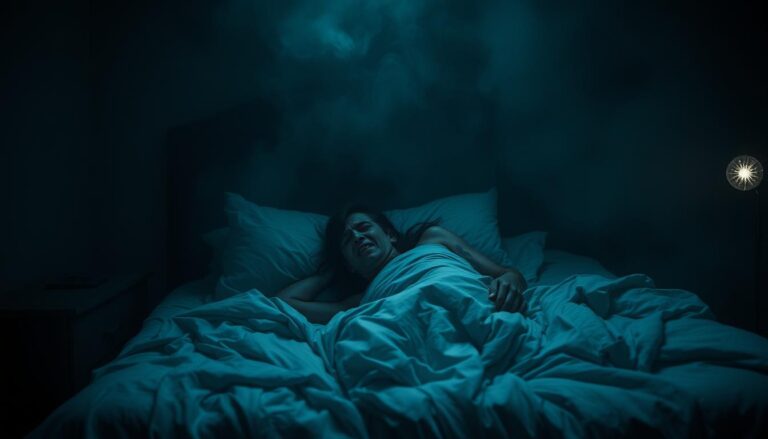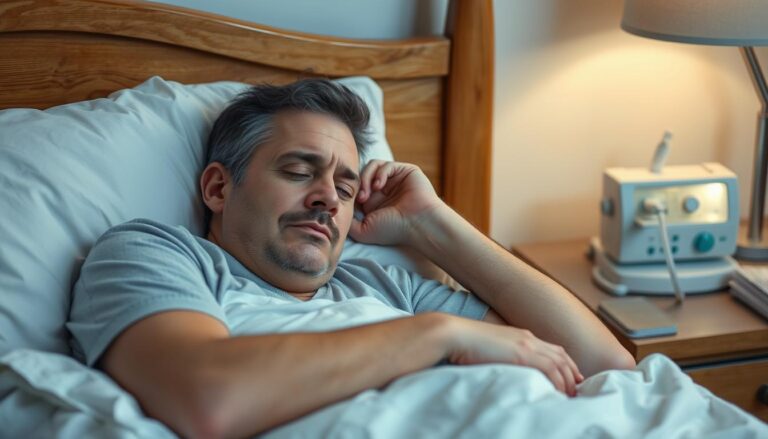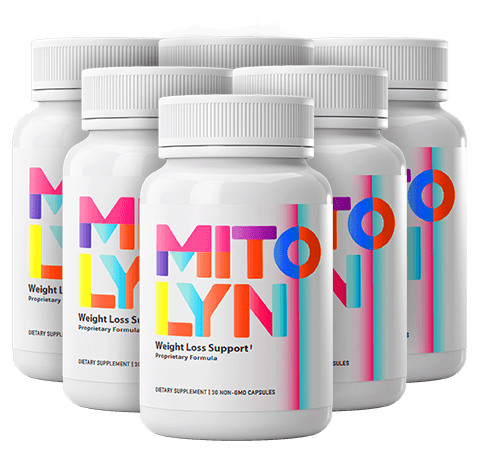
Over 90 million U.S. adults snore every night. Two-thirds of Americans snore sometimes. This guide helps you find the best anti-snoring mouthguards for side sleepers. You’ll learn about options from $40 to $1,295.
Learn how MADs and TRDs open airways while you sleep. Devices like the SnoreRx ($60) and Smart Nora ($359) are great. Most offer 30–60 night trials and adjustments up to 10mm.
Discover which snoring solutions are best for your budget and comfort. This guide makes choosing easier.
Key Takeaways
- Over 90 million adults snore, making snoring solutions essential for better sleep.
- Prices span $40 for the Sleepon M2 to $1,295 for custom devices like the American Sleep Dentistry appliance.
- Adjustable MADs and TRDs allow jaw adjustments up to 10mm, like the CareFusion ApneaRx or SnoreRx.
- Most devices include 30–60 night trials, and some require prescriptions for custom fittings.
- Common side effects like jaw soreness often ease over time, while the Somnofit-S ($150) lasts longer than most.
Understanding Snoring Problems for Side Sleepers
Snoring is common, affecting over 40% of women and 50% of men in the U.S. Side sleepers often wonder why they still snore. Even on your side, your tongue or throat can relax, narrowing airways and causing vibrations.
This blockage doesn’t pick favorites—44% of men and 28% of women aged 30–60 snore regularly.
Why Side Sleepers Still Snore
Your body shape is a big factor. A thick soft palate, extra throat tissue, or how your head rests on the pillow can block airflow. Imagine your tongue falling back when you sleep, even on your side.
Studies show that tongue-retaining devices can cut snoring by 68%. This shows how side sleeper mouthguards can help.
The Impact of Snoring on Sleep Quality
Snoring messes with your deep sleep, making you tired. It can lead to feeling tired during the day, mood swings, and memory problems. Almost 25% of kids snore, often because of allergies or big tonsils.
For adults, being overweight raises the risk—losing weight can reduce snoring by up to 30%. Smoking and drinking before bed also make it worse.
Common Challenges with Traditional Devices
- Many snore guards for side sleeping don’t fit right, causing jaw pain or discomfort.
- Devices like Breathe Right Strips often fall off, offering little help.
- Some options, like the Philips SmartSleep Band, didn’t fit the needs of different sleep positions.
Choosing the right side sleeper mouthguards is key. They need to fit how your body rests to work well.
How Anti-Snoring Mouthguards Work to Prevent Snoring
Anti-snoring mouthpieces move your jaw or tongue to keep your airway open. Devices like mandibular advancement devices (MADs) gently move your lower jaw forward. This stops throat tissues from collapsing.
Tongue-retaining devices (TRDs) keep your tongue from blocking your airway. This stops vibrations that cause snoring sounds.
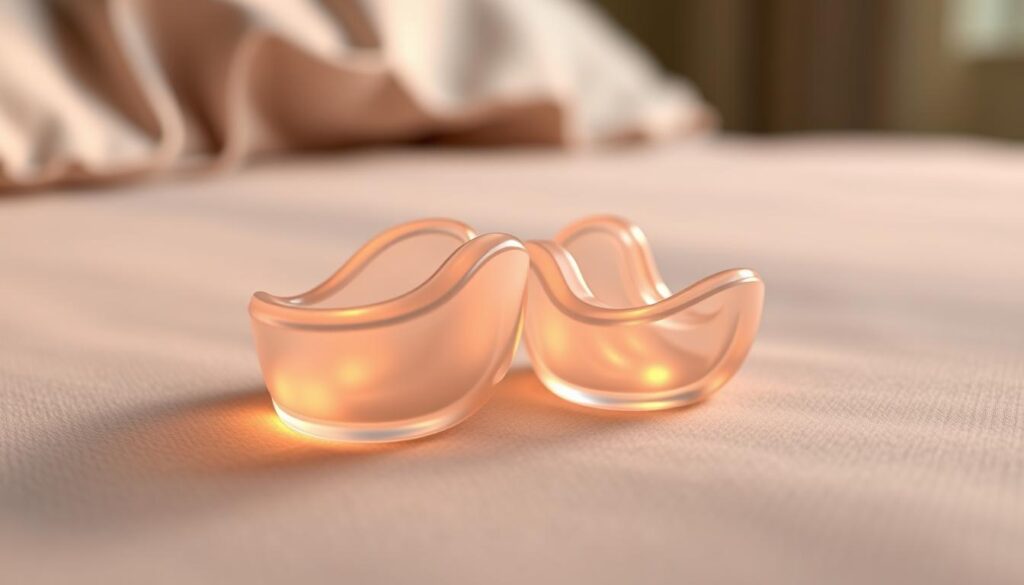
These devices are made for comfort, even when you sleep on your side. They use medical-grade silicone or plastic that fits your teeth. Look for adjustable models to avoid jaw stiffness.
Here’s how different types compare:
| Type | How It Works | Best For |
|---|---|---|
| MADs | Shifts jaw forward to open airways | Users with mild snoring or OSA |
| TRDs | Prevents tongue from blocking airways | People with tongue-based snoring |
“What might work in Year 1 may not work in Year 2,” warns the American Sleep Association, advising regular dentist checkups to adjust fit. Some users report dry mouth or teeth discomfort, but custom-fit options from dentists reduce these risks. Over-the-counter options like ZQuiet or Sleep Legends offer budget-friendly choices, while medical-grade devices are FDA-approved for severe cases.
Choose a mouthguard that stays in place when lying on your side. Look for breathable materials and read reviews—over 1,000 products exist, but effectiveness varies. Always consult a dentist before use, especially if you have dental issues or severe sleep apnea.
Types of Anti-Snoring Mouthguards for Side Sleepers
Choosing the right best anti-snoring devices starts with understanding your options. Side sleepers often face unique challenges. But two main types of mouthguards stand out: Mandibular Advancement Devices (MADs) and Tongue Retaining Devices (TRDs). Each design addresses snoring causes differently. Knowing your preferences helps pick the right fit.
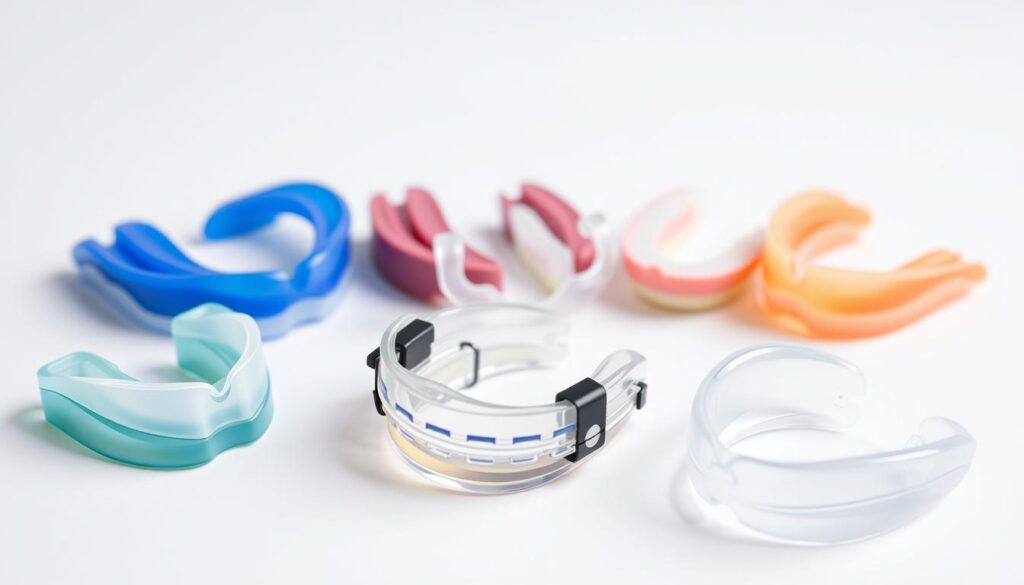
Mandibular Advancement Devices (MADs)
MADs work by gently moving your jaw forward to open your airway. The SnoreRx Mouthpiece, for example, uses a boil-and-bite mold to fit your teeth. Its adjustable 1mm settings let you find the perfect jaw position—typically 3-5mm forward—to reduce snoring. These devices cost between $50 to $150, with the SnoreRx Plus offering premium comfort at $124.
Tongue Retaining Devices (TRDs)
TRDs use a suction cup to hold your tongue in place, preventing it from blocking your throat. Unlike MADs, they don’t shift your jaw but require getting used to a “pacifier-like” design. Ideal for those preferring non-jaw adjustments, TRDs often come in reusable materials for lasting use.
Customizable vs. One-Size-Fits-All
- Customizable anti-snoring products like boil-and-bite MADs mold to your teeth, offering a personalized fit.
- One-size options are cheaper but may feel less snug. The SnoreRx Mouthpiece’s 5-minute setup makes customization easy without a dentist.
Prescription vs. Over-the-Counter
OTC mouthguards like SnoreRx offer instant access at $60-$150. Prescription devices, while pricier, provide tailored adjustments for severe cases. Both types last 6-18 months with proper care—boil-and-bite models need daily cleaning to stay effective.
Key Features to Look for in Side Sleeper Mouthguards
When picking sleep aids for snorers, focus on what you need. Anti-snoring mouthguards for side sleepers should be comfy, adjustable, and last long. They should also work well.
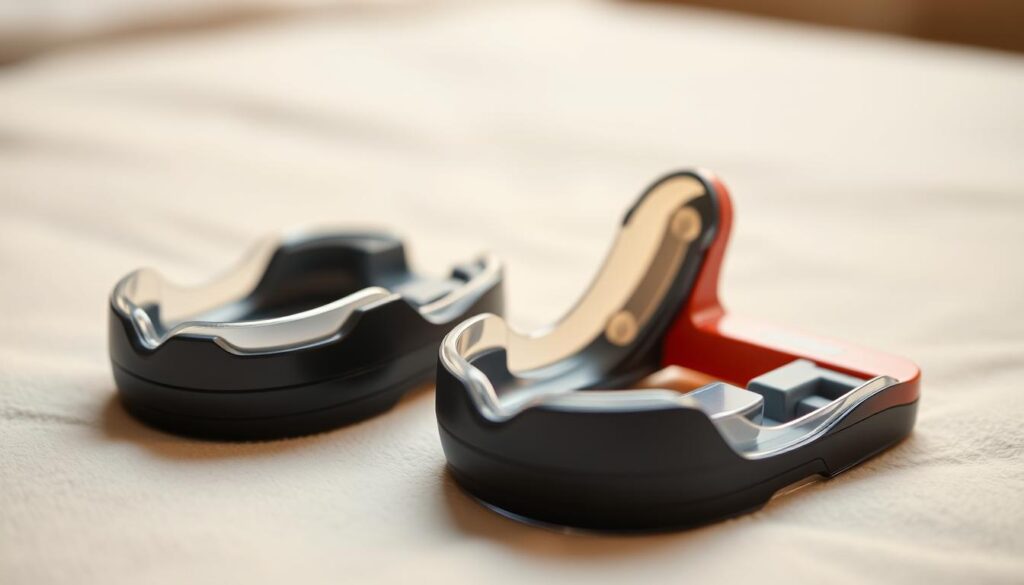
- Choose soft, medical-grade silicone to avoid cheek or gum irritation.
- Look for low-profile designs that don’t press hard against pillows.
- Avoid rigid plastics that might crack or feel uncomfortable over time.
Adjustability and Customization:
- Choose MADs with adjustable jaw positions to fine-tune airway support.
- Boil-and-bite options let you mold devices to your teeth at home.
- Custom dentist-fitted guards often work best for severe snoring or OSA.
Durability and Maintenance:
- Check if the mouthguard resists warping after repeated use.
- Look for dishwasher-safe or easy-to clean materials.
- Some devices last 6–12 months before needing replacement.
Price vs Value:
| Feature | OTC Options ($50–$150) | Custom Options |
|---|---|---|
| Comfort | Basic fit | Perfect fit |
| Longevity | 6–12 months | 2+ years |
| Cost | Lower upfront | Higher but often covered by insurance |
Investing in durable materials and adjustability means your sleep aid will last. Custom options might cost more but save money in the long run. Check if your insurance covers dentist-fitted devices. Many policies now support sleep apnea treatments.
Top-Rated Anti-Snoring Mouthguards for Side Sleepers
Looking for snoring solutions that fit your sleep style? Here are the best anti-snoring devices for side sleepers. They help you breathe better and sleep quieter:
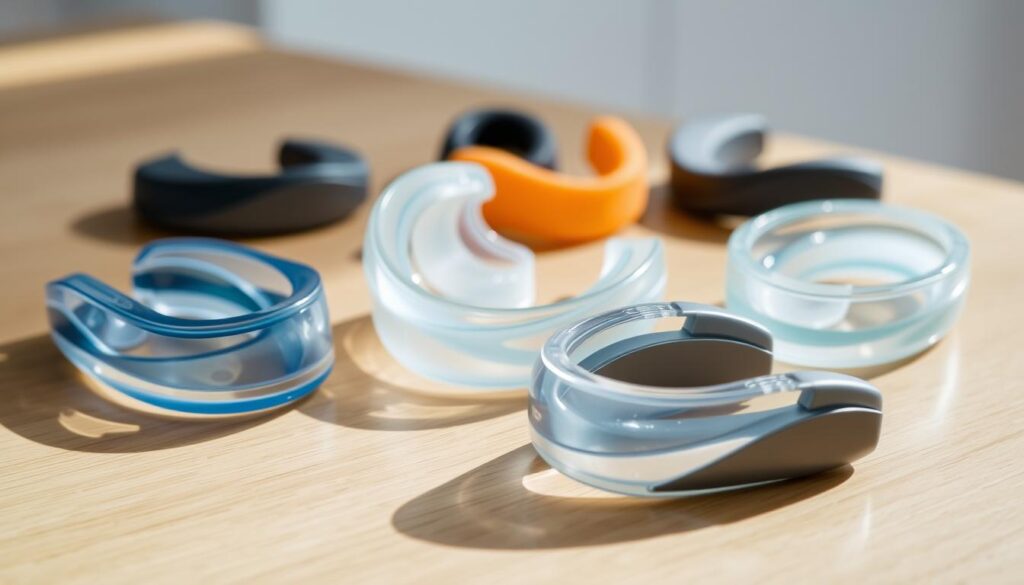
- SnoreRx Plus: It fits you well with a 30-night guarantee. Its slim design is perfect for side sleepers. It costs $70 on Amazon.
- Somnofit-S: It’s made of soft, medical-grade material and comes with a 60-night trial. Its shape keeps your jaw in place without pain. It’s $85.
- SmartGuard: It has a 90-day trial and adjusts by 2 millimeters. It works for both back and side sleepers. It starts at $99.
For those on a budget, the Good Morning Snore Solution (FDA-approved) is $90. It keeps your airways open. The Zquiet has two jaw sizes and costs $120. All are BPA-free and dishwasher-safe for easy cleaning.
Over 45% of adults snore sometimes. But these devices can cut down on noise by up to 80%, say users.
Think about your budget: OTC mouthguards start at $20, while custom ones can be over $1,500. Brands like VitalSleep and PureSleep offer 60-day trials. Look for jaw gaps of 1–6mm and materials like medical-grade silicone for comfort.
Need more help? Try a wedge pillow (10–12 inches high) to lift your head. Nasal strips like Breathe Right (26/pack) or nasal dilators like Rhinomed can also help. Always talk to a doctor if you snore a lot or feel tired during the day.
Conclusion: Breathing Easier and Sleeping Better with the Right Mouthguard
Choosing the right anti-snoring mouthguard can change your sleep for the better. In the U.S., 90 million adults snore. MADs and TRDs are proven to help.
Devices like ApneaRx and SnoreRx are backed by science and are comfy. SnoreRx makes 90% of users happy, and ApneaRx offers a 30-day guarantee. MyTAP and SomnoGuard AP2 can cut snoring by up to 80%, beating CPAP’s 40% success rate.
Custom mouthguards like SleepOn M2 and enCore Guards fit perfectly. ZQuiet and VitalSleep let you try them risk-free for 60 nights. American Sleep Dentistry and ZYPPAH offer FDA-approved, tailored solutions.
MADs help with breathing and snoring. But, see a doctor if you think you have sleep apnea. Look for mouthguards that are comfy and last long.
With so many choices, you can find the perfect one. It means quieter nights and more energy. The right mouthguard helps you and your partner sleep better.






